ASUS F1A75-I Deluxe Review – Llano and Mini-ITX
by Ian Cutress on October 1, 2011 5:30 PM EST- Posted in
- Motherboards
- Asus
- A75
Test Setup
| Processor |
AMD Llano A6-3650 4 Cores, 4 Threads, 2.6 GHz |
| Motherboards | ASUS F1A75-I Deluxe |
| Cooling | Corsair H50-1 |
| Power Supply | Silverstone 1000W 80 PLUS Silver |
| Memory |
G.Skill RipjawsX DDR3-1866 9-10-9 28 2x4GB Kit 1.5V Patriot Viper Xtreme DDR3-2133 9-11-9 27 2x4 GB Kit 1.65V |
| Memory Settings | DDR3-1866 |
| Video Cards |
XFX HD 5850 1GB ECS GTX 580 1536MB |
| Video Drivers |
Catalyst 10.12 / 11.8 NVIDIA Drivers 280.26 |
| Hard Drive |
Micron RealSSD C300 256GB OCZ Vertex3 240GB |
| Optical Drive | LG GH22NS50 |
| Case | Open Test Bed - CoolerMaster Lab V1.0 |
| Operating System | Windows 7 64-bit |
| SATA Testing |
Micron RealSSD C300 256GB OCZ Vertex3 240GB |
| USB 2/3 Testing | Patriot 64GB SuperSonic USB 3.0 |
As part of our test setup, we are slowly migrating to newer drivers for our discrete GPU tests, as well as updating the tests appropriately. However, as it is only fair to test like for like, comparisons will only be made with results achieved with the same drivers.
Comparison to Other Reviews
Where applicable, the results in this review are directly compared to the following chipsets and boards which we have reviewed previously:
Note: The main comparison point for the ASUS F1A75-I Deluxe for us is the ASRock A75 Extreme6 we have already tested. As a result of that review, which was run with DDR3-1333 settings to compare to Sandy Bridge boards, I have been asked to run future Llano reviews at DDR3-1866, which Llano supports natively. For logistical reasons, there is also a CPU discrepancy, where today we are using an A6-3650 (2.6 GHz, 320 SP IGP), and in the A75 Extreme6, an A8-3850 (2.9 GHz, 400 SP IGP) was used. In analysing the results, these factors will be taken into account.
Power Consumption
Power consumption was tested on the system as a whole with a wall meter connected to the power supply, while in a dual GPU configuration. This method allows us to compare the power management of the UEFI and the board to supply components with power under load, and includes typical PSU losses due to efficiency. These are the real world values that consumers may expect from a typical system (minus the monitor) using this motherboard.
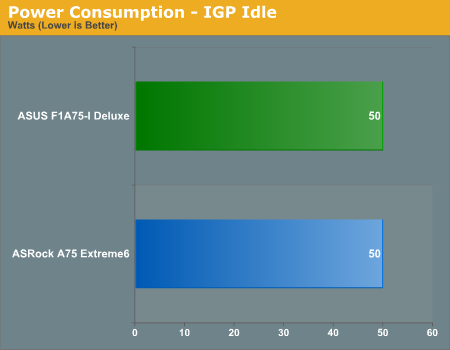
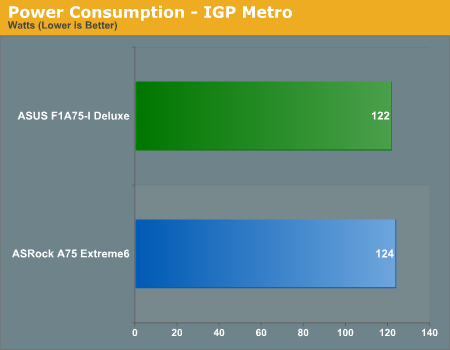

The only board to compare the F1A75-I Deluxe to is the A75 Extreme6 board I reviewed a few months ago. Both boards perform similarly.
CPU Temperatures
With most users running their boards on purely default BIOS settings, we are running at default settings for the CPU temperature tests. This is, in our outward view, an indication of how well (or how adventurous) the vendor has their BIOS configured on automatic settings. With a certain number of vendors not making CPU voltage, turbo voltage or LLC options configurable to the end user, which would directly affect power consumption and CPU temperatures at various usage levels, we find the test appropriate for the majority of cases. This does conflict somewhat with some vendors' methodology of providing a list of 'suggested' settings for reviewers to use. But unless those settings being implemented automatically for the end user, all these settings do for us it attempt to skew the results, and thus provide an unbalanced 'out of the box' result list to the readers who will rely on those default settings to make a judgment.
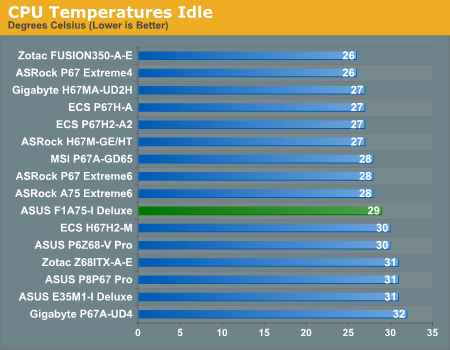
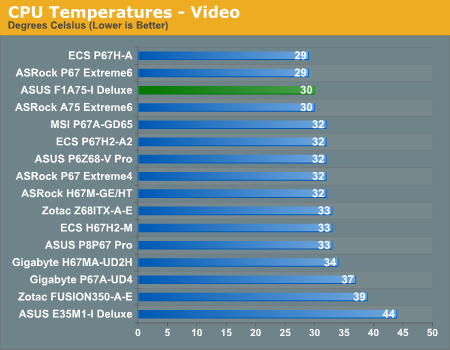
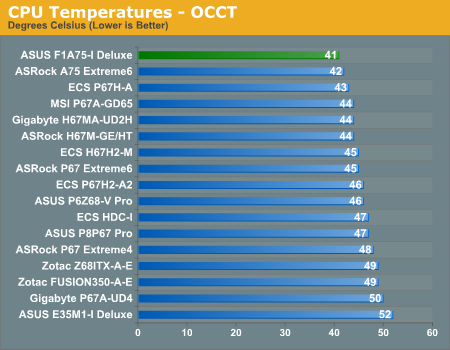
Compared to the board we have tested, the F1A75 Deluxe does well on CPU temperatures, even compared to the low powered Fusion boards with passive cooling, and the Sandy Bridge boards.










51 Comments
View All Comments
bijeshn - Monday, October 3, 2011 - link
How good is the onboard wireless 802.11 b/g/n implementation on this board?mitcoes - Monday, October 3, 2011 - link
I do think this devices are ATOM competence.As they provide a remote control, pobrably to be used as set top boxrs attached to TVs.
Google TV, Android, Desktop Linux, and even Hackintosh are the OSs that will run better.
MS WOS is for AMD Phenom and bulldozers or iNTEL I3 to i9 not for Llano or ATOM.
At this kind of devices nix works far more better than MS WOS.
Death666Angel - Monday, October 3, 2011 - link
And why exactly is that?Also, can Linux play commercial blurays, yet? Can I legally install MacOS on a non-Apple PC? Does Google TV or Android have an easy installation routine and easy navigation on a PC?
CharonPDX - Monday, October 3, 2011 - link
*SEEMS* good. But to use a USB dongle, rather than either CIR (standard WinMCE protocol) or Bluetooth seems dopey. Heck, I'd like to see it use CIR for the WinMCE side, and Bluetooth for the keyboard/mouse half...MobiusStrip - Monday, October 3, 2011 - link
When these babies have Thunderbolt, they're gonna rock.justniz - Tuesday, October 4, 2011 - link
Please stop using 1024x768 for gaming benchmarks.I'm pretty sure practically no gamer uses a 4:3 monitor or plays in such a low resolution.
Whats wrong with 1920x1080?
Furthermore with any modern GPU, at such a low res th'eres a strong chance all you're maxing out is the DMA bandwidth to/from the GPU, not its rendering muscles.
mariush - Tuesday, October 4, 2011 - link
Actually a better resolution would be 1280x720.Since it's 16:9, various wide format monitors would not distort the image and since it's HDMI native TVs would probably upscale it just fine to 1920x1080.
Such resolution is suitable to test on board video cards (and cpu embedded video cards) - with higher resolutions you may get into memory bandwidth issues and then you're not really testing the gpu anymore..
ddrum2000 - Wednesday, October 5, 2011 - link
I agree with many that this review is a bit flawed. I'd like to see this board compared to the AsRock A75M-ITX and the Zotac A75ITX-A-E . In addition the A8-3850 is not the best HTPC CPU because of the high TDP. The A8-3800 with a 65 W TDP (I think) would be a much better HTPC comparison. Thanks to the person who said that the Scythe Big Shuriken will not fit as the was the cooler I was planning to use. Thoughts?AnnihilatorX - Thursday, October 6, 2011 - link
I am looking for a power efficient mini-ITX buildI was hoping to see some power consumption benchmark :/
Soulkeeper - Sunday, October 16, 2011 - link
I think your motherboard review would be improved if you included the following:A table containing the bios min/max for all voltage, fsb, mult, etc. settings
Tomshardware does this when they compare motherboards and it's really helpful :)
Also I can't help but wonder if the wifi can be removed and replaced with a mSATA/'miniPCIe' SSD and used as the boot drive.
Thank you